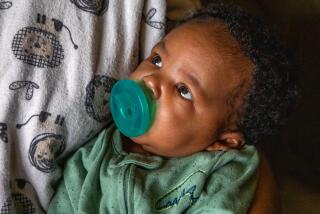Researchers Find Key Clue to SIDS as Killer of Babies : Health: Chemical flaw is detected in victims. The finding eventually could help spot infants at risk.
- Share via
Sudden infant death syndrome has always been so puzzling that its name describes only what happens, without betraying a hint of why. But for the first time, researchers have identified a specific abnormality in brain chemistry that appears to contribute to SIDS, the leading killer of babies between a month and a year old.
About 6,000 die of SIDS each year in the United States. But the fear that the disorder arouses and the psychological toll it exacts on parents are immeasurable, precisely because of the seemingly mythic way it takes the life of a normal baby with no warning in the middle of the night.
The new research, by pinpointing a chemical defect in a part of the brain stem that appears to control breathing during sleep, dispels some of the nightmarish mystery and randomness characteristic of crib death.
Judith S. Jacobsen, vice president of the SIDS Alliance, a nonprofit group that partly funded the research, said it “will go a long way toward improving our understanding and hastening the elimination of this dread disease.”
Dr. Hannah C. Kinney, a neuropathologist at Children’s Hospital in Boston, headed the research team that conducted the study, which appears in today’s issue of the journal Science.
She emphasized that the discovery was a “clue” to SIDS, not an outright cause of it. And though doctors cannot test for the brainchemical defect in babies, she said, “our hope is that we will be able to in the future.” Eventually, she said, researchers might develop “drugs or some other therapy to correct” the problem.
“Marvelous work,” said Dr. Thomas G. Keens, a pediatric researcher at Childrens Hospital in Los Angeles and an adviser to the California SIDS Advisory Council. “She may well have identified a group of kids who are more vulnerable” to SIDS.
In California in 1993, the most recent year analyzed by the Department of Health Services, there were 524 SIDS deaths; in Los Angeles County, 190. Statewide, the SIDS incidence has fallen from 1.7 per 1,000 live births in 1980 to 0.9 in 1993. Researchers cannot fully explain that drop, but suggest that it may have been abetted by parents’ increased vigilance in making sure that babies sleep on their backs, which cuts the risk of SIDS.
In their study, Kinney and her co-workers analyzed brain tissue from 45 babies who died of SIDS and 32 who died of other causes. They zeroed in on a tiny part of the brain stem called the ventral medullary surface. It is believed to regulate breathing by monitoring and controlling blood levels of carbon dioxide, which in excessive amounts result in suffocation.
What the researchers found was that, on average, brain stem cells from SIDS victims were less receptive than those of other babies to a crucial nerve chemical called acetylcholine. This neurochemical is critical to communication between these and other brain cells. Like a fire alarm with a weak battery, the defect in the cells’ acetylcholine receptors, the medical scientists speculate, leaves a baby unable to respond in time when carbon dioxide builds up in the blood.
The idea fits nicely with earlier studies indicating a higher risk of SIDS in babies who slept on their stomachs. In addition to the risk of being suffocated by bedding, face-down sleeping inclines a baby to breathe back in exhalations heavy with carbon dioxide, researchers say.
Though the great majority of babies in that circumstance respond by taking deeper breaths, waking up or starting to wail, a baby with a defect in the brain stem’s carbon dioxide alarm might not react.
Another thing believed to put babies at higher risk of SIDS is secondhand smoke, but Kinney says her brain chemistry study did not directly address that factor.
Given that a direct test of acetylcholine receptors in the brain stem is not available, Kinney said, one avenue of research is to look for a substance in blood that mirrors the receptor function. If there is one, it might enable physicians to screen babies and take steps to protect those whom the defect puts at risk of SIDS.
Most SIDS researchers believe that the disorder has complex origins. “The infant’s age, ability to mount protective physiologic responses and environment may interact to dictate an infant’s risk of dying from SIDS at any given time,” Keens said.
(BEGIN TEXT OF INFOBOX / INFOGRAPHIC)
Reducing the Risk
Things parents should know and do to prevent Sudden Infant Death Syndrome:
During pregnancy:
* Get early prenatal care.
* Don’t smoke.
Once the baby is born:
* Place the baby on his or her back or side to sleep.
* Minimize or eliminate the baby’s exposure to cigarette smoke.
* Use firm bedding materials.
* Avoid overcoddling the baby at bedtime or overheating the nursery.
* Breast-feed, if possible.
Other factors:
* SIDS occurs more often in cold-weather months.
* The younger the mother, the greater the risk. Infant boys are at somewhat higher risk than girls. Nearly 90% of victims are under 6 months.
* There is also a slightly higher incidence of SIDS among premature and low-birth-weight infants, twins and triplets.
Source: SIDS Alliance






